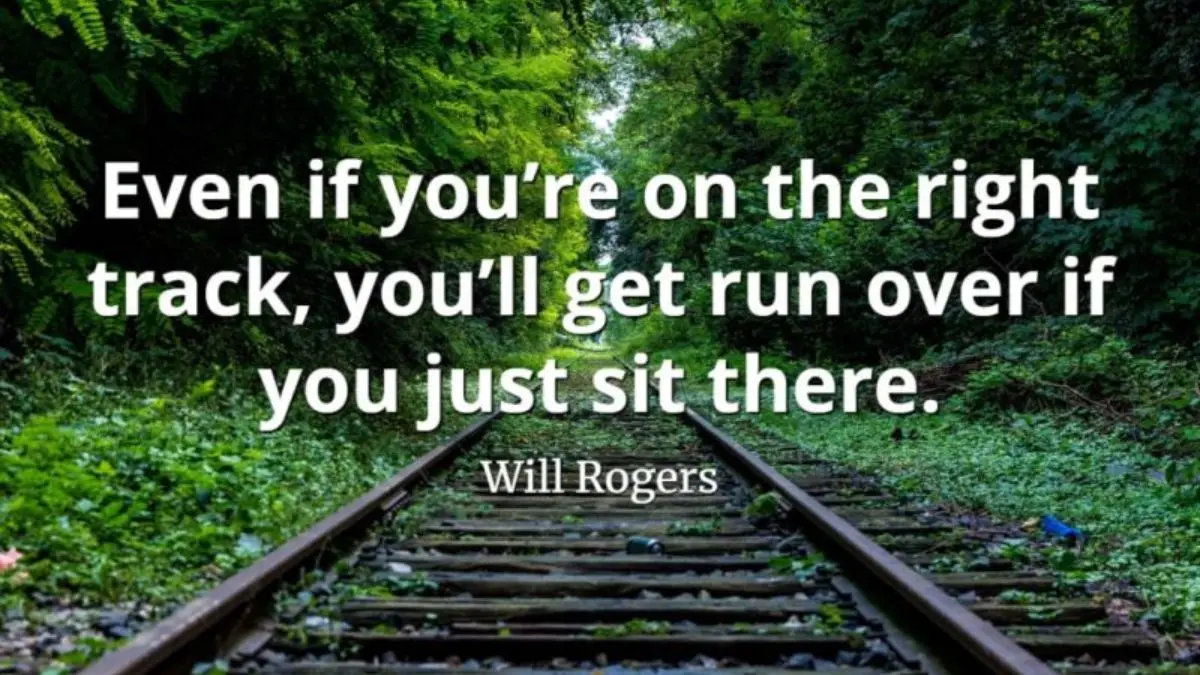The timeless words of American humorist Will Rogers, “Even if you are on the right track, you’ll get run over if you just sit there,” serve as a powerful reminder in our fast-paced world. This adage, simple yet profound, encapsulates the essence of progress and the perils of stagnation. In a society that values achievement and constant evolution, understanding and applying this wisdom can mean the difference between success and obsolescence. As we delve into the layers of this statement, we uncover its applicability not just in personal ambitions but also in professional endeavors and the broader journey of life.
The Right Track Is Just the Beginning
Finding oneself on the ‘right track’—be it in personal development, career trajectory, or nurturing relationships—is undeniably exhilarating. This moment of clarity, when the fog of uncertainty clears, is often celebrated as a pivotal achievement. However, this is merely the starting point, not the destination. The right track represents the alignment of one’s actions with their goals and values, a necessary foundation for any journey worth embarking on. Yet, there’s a common misconception that once this path is found, success is inevitable. Reality, with its twists and turns, demands more than just alignment; it requires motion, persistence, and the willingness to adapt.
The Dangers of Complacency
Complacency sets in when we become too comfortable with our current achievements and stop striving for further growth. It’s the silent dream killer that often goes unnoticed until it’s too late. In both personal endeavors and professional environments, the signs of complacency can include a lack of innovation, resistance to change, and a decrease in performance levels. This stagnation not only hampers individual progress but can also lead to the downfall of entire organizations.
Consider the example of once-dominant companies that failed to innovate and adapt to changing market conditions. Their stories serve as stark reminders that success today does not guarantee success tomorrow. Similarly, on a personal level, failing to challenge oneself or explore new opportunities can lead to a sense of unfulfillment and regret. The key takeaway is clear: motion, not merely direction, is essential for sustained success.

Embracing Continuous Improvement
The antidote to complacency is the pursuit of continuous improvement, a concept deeply ingrained in both personal development philosophies and successful business strategies. This approach is about consistently seeking ways to better oneself and one’s circumstances, irrespective of past successes. It involves setting new goals, learning from both successes and failures, and always looking for opportunities to grow.
Individuals can embrace continuous improvement by cultivating a mindset of lifelong learning, setting incremental goals, and seeking feedback regularly. Organizations, on the other hand, can foster this culture by encouraging innovation, rewarding initiative, and providing opportunities for professional development. The journey of continuous improvement is not about a destination but about the journey itself, marked by constant progress and adaptation.
Overcoming Obstacles to Progress
Despite the best intentions, numerous obstacles can hinder our progress on the track of continuous improvement. Fear of failure, lack of motivation, and the absence of clear goals are among the most common challenges. However, each of these obstacles can be overcome with the right mindset and strategies.
To conquer the fear of failure, it’s crucial to reframe failures as learning opportunities rather than setbacks. Embracing a growth mindset helps individuals perceive challenges as chances to evolve rather than insurmountable barriers. Boosting motivation can be achieved by setting clear, achievable goals and celebrating small victories along the way. Finally, establishing clear, meaningful goals requires introspection and a deep understanding of one’s values and aspirations. By addressing these obstacles head-on, the path of continuous movement becomes not only possible but also enjoyable and fulfilling.
Conclusion
Will Rogers’s wise words remind us that being on the right track is merely the beginning of a journey, not its end. The real challenge—and opportunity—lies in the continuous pursuit of progress. This journey demands action, perseverance, and a willingness to embrace change and overcome obstacles. As we reflect on our paths, let us not be content with simply finding the right track. Instead, let’s commit to moving forward, constantly seeking improvement and embracing the journey with all its ups and downs. By doing so, we ensure that we are not only on the right track but also moving towards a brighter, more fulfilling future.
Now is the perfect time to evaluate where you stand and where you’re headed. Are you moving, or have you allowed complacency to set in? Remember, the world around us is always moving forward, and to keep up, we must do the same. Let’s take that step, however small, towards continuous improvement and never forget that the journey of progress is an endless pursuit of becoming our best selves.




